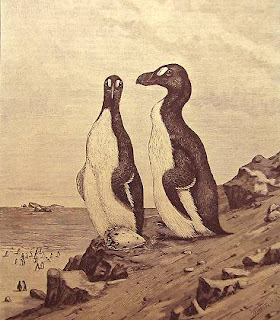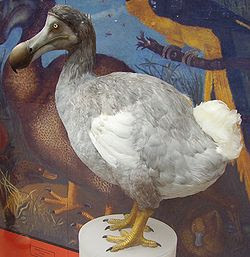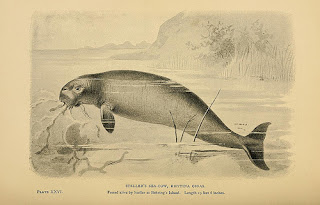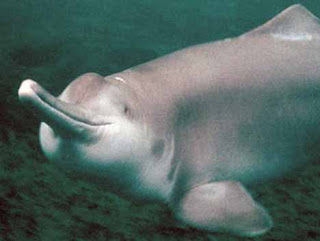10.Tasmanian tiger
They looked like something between a tiger and a dog.In fact it was a carnivorous marsupial, complete with pouch.Native to Australia, the thylacine was last seen on that mainland over 2,000 years ago. The tiger was hunted to extinction by the indigenous population.They found a save place to lice in island Tasmania. But when Europeans reached the island their population starts to decreases.Their heavy-handed hunting, prompted in part by farmers' protection of their livestock, brought the animal to minimalist numbers by the early 20th century.The last one was caught in 1933 and died three years later in a zoo in Hobart, Australia.
9.Great Auk (penguin)
At nearly 3 feet tall, the great auk was a large bird, indeed, but a story involving one of the last living auks was perhaps more unusual than its size.
The last known auk in Scotland was executed in 1840, after local villagers thought that it was a witch. Really. While the auk was unlikely actually a witch, the penguin-like species was the last flightless bird in the Northern Hemisphere and once inhabited islands off the coast of northern Europe and northeastern North America. Hunted as food and bait, the last auks were observed in 1844 off the coast of Iceland8.The Dinosaurs
They were gone long before the first human graced the planet, yet they've still managed to capture the hearts of school kids across the globe, thanks to the toys, cartoons and museums full of skeletons extolling their prior existence.
And wouldn't it be nice if the dinosaurs all lived together like they do in the movies, playing, fighting and hunting? Think more The Land Before Time and less Jurassic Park, more plant-eaters and fewer Velociraptors. The reality is that many of the more famous dinosaur species never even crossed paths.7.The Dodo bird
The flightless bird, native to the island of Mauritius, in the Indian Ocean, was known to mankind for less than 100 years ... but that's all it took for us to eradicate the species.
It wasn't so much that humans killed the stubby, rotund birds directly, but our decimation of their habitat and food source did an awful lot to hasten their demise. Also pigs, dogs and other predators ravaged the birds' nests and generally harassed them. The last dodo died sometime in the late 17th century.6.Steller's Sea Cow
A relative of the smaller, much-beleaguered manatee, the gentle sea cows were over 25 feet long and may have weighed as much as 10 tons.By the time German naturalist Georg Steller found and described them in 1741, their population was already threatened, perhaps due to hunting by indigenous peoples. Their extermination would quickly continue with the arrival of Alaska-bound European fishermen and seal hunters. The sea cows were rapidly hunted for food, skins (used to make boats) and oil (for lamps), and by 1768, less than 30 years after Steller found them, the Steller's sea cow was extinct.
5.The Quagga
Once upon a time, the quagga was standard fare in European zoos. The caramel brown zebra subspecies has been missing from the planet since the 19th century, but that hasn't stopped some from trying to resurrect it.
Since 1987, the South Africa-based Quagga Project has been using selective breeding among plains zebras to mimic the animal's unique markings -- most notably, its distinctive striping pattern, which starts at the head but extends back only as far as mid-body.Native to South Africa, the original quagga was hunted to extinction for its meat and hide. The last one died in an Amsterdam zoo in 1883.4.Baiji White Dolphin
Native to the Yangtze River in China, the freshwater dolphin was nearly blind and quite intelligent. A 2006 expedition searched the Yangtze for six weeks, but didn't find any Baiji, marking an end to a species that had been a part of the river since ancient times.
The aquatic mammal had fallen prey to hunters and fishermen, as fishing boats, complete with their entangling gear, began to crowd the river in the 1950s and '60s. A reported sighting in 2007 raised hopes, but most scientists argue that if a few of the Baiji do still exist, their numbers are most likely so small as to make them "functionally extinct," meaning they're beyond a comeback.3.The Saber-toothed Tiger (Smilodon)
He's the cat you see in picture books about prehistoric times, the one that got trapped (and preserved) in the La Brea tar pits while hunting mammoths. He's been gone from the Earth for over 10,000 years now, but those huge canine teeth, now believed to be used primarily for (eek) ripping open prey, still inspire awe.
The cat itself was about the size of a modern-day lion (if not a bit shorter), but far more robust. Since the fierce predator once roamed freely in the grasslands and forests of North and South America, we should probably just be happy we're not living in the Ice Age.2.Large Rodents
The rodent that lived in South America between 2 and 4 million years ago was closer in relation to a guinea pig than a rat; however, fossilized remains discovered in 1987 indicate that Josephoartigasia monesi was 10 feet long and likely weighed over 1,000 pounds.
1.Zanzibar Leopard
One of several
subspecies of leopard, the Zanzibar leopard made its home on the
Zanzibar archipelago of Tanzania. It's still unclear whether this large
cat is technically extinct — there are occasional unconfirmed sightings.
Locals believed the leopards were kept by witches, and aggressively hunted them. The animals were seen as evil predators that must be exterminated — and even the goverment was in on the campaign. In the mid-'90s there was a short-lived conservation effort but it was deemed too little, too late.
Locals believed the leopards were kept by witches, and aggressively hunted them. The animals were seen as evil predators that must be exterminated — and even the goverment was in on the campaign. In the mid-'90s there was a short-lived conservation effort but it was deemed too little, too late.










No comments:
Post a Comment